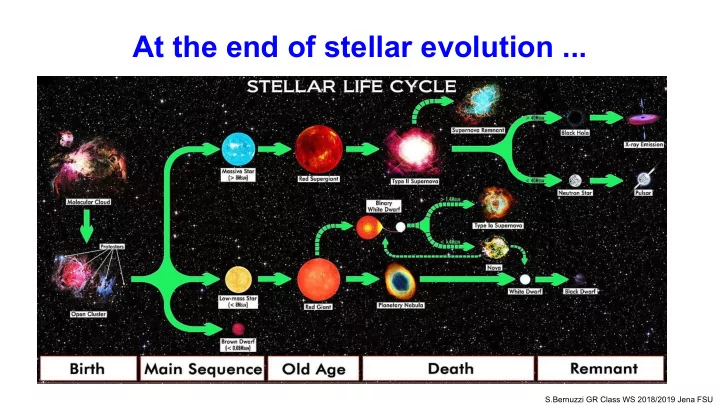

At the end of stellar evolution ... S.Bernuzzi GR Class WS 2018/2019 Jena FSU
… Black Holes K.Schwarzschild 1916 S.Bernuzzi GR Class WS 2018/2019 Jena FSU
Gravitational collapse & black hole formation S.Bernuzzi GR Class WS 2018/2019 Jena FSU
Quasars C348 @ 1.4GHz ● 50s Radio sources of small size ● 60s Optical counterparts w\ High redshift (z ~ 7) ● Very luminous & extra-galactic? (> nuclear fusion, supernovae) ● 1964 Salpeter&Zeldovich: Supermassive BH + accretion disk ● Confirmed by ○ X ray observations of BH ( next slide ) 0.5 arcsec ○ 1971 Peterson and Gunn: Galaxies containing quasars showed the same redshift as the quasars ○ 1979 Walsh,Carswell&Weyman: Grav. Lensing S.Bernuzzi GR Class WS 2018/2019 Jena FSU
X-ray astronomy ● Hot gases at T ~ 1,000,000K emit X-ray ● 1962 Scorpius X-1 ○ Strongest X-ray source together the Sun. ○ Low-Mass-X-ray binary ○ 1.4Mo NS + 0.42 star ● 1964 Cygnus X-1 ○ High-Mass-X-ray binary ○ 14.8Mo BH + 20-40Mo supergiant star R.Giacconi Nobel Prize 2002 S.Bernuzzi GR Class WS 2018/2019 Jena FSU
Gravitational waves from black hole collisions since 2015, LIGO-Virgo observations Weiss,Barish,Thorne Nobel Prize 2017
Sagittarius*A Galaxy center; Orbits’ speed ~ 2% c Mass ~ 4 million M Sun ! => Supermassive BH S.Bernuzzi GR Class WS 2018/2019 Jena FSU
… Neutron stars Baade / Zwicky 1933 ● Compact stars − M~1.5 Msun, R~12 km → C = GM/(Rc 2 ) ~ 0.1 − n ~ 0.3 baryon/fm 3 (6-8 10 14 g/cm3) − T ~ 10 6 K << T Fermi ~ 10 12 K ● Formation: gravitational collapse of massive stars (> 8M Sun , Type II SNCC) ● Extreme density matter → unknown composition and equation of state ( EOS ) P = P(n,T) ● Stellar models need to include GR effects − Tolmann–Oppenheimer–Volkoff equations − Spherical symmetry − EOS P=P(n) (in weak equilibrium) ● Maximum mass and stability [Lattimer&Prakash 2004] S.Bernuzzi GR Class WS 2018/2019 Jena FSU
Pulsar observations Bell / Hewish 1968 (Ryle & Hewish Nobel prize 1974) S.Bernuzzi GR Class WS 2018/2019 Jena FSU
Neutron stars in binary systems 1993 Nobel prize: Hulse & Taylor PSR B1913+16 [Weisberg&Taylor 2004]
Gravitational and electromagnetic signals from a neutron star collision August, 17th 2017, 12:41:01 UTC GW170817 S.Bernuzzi GR Class WS 2018/2019 Jena FSU
Recommend
More recommend